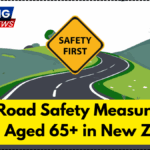The New Zealand government is overhauling how traffic violations are enforced, with major updates to come in July 2025. As part of a broader road safety initiative, New Zealand Traffic Fine Changes will include the introduction of camera-based fines aimed at improving compliance and reducing fatalities on the roads. These changes mark a shift from traditional police-issued penalties to a more automated, tech-driven enforcement model. Here’s what every driver needs to know.

New Traffic Fine Rules in NZ
| Detail | Information |
|---|---|
| Policy Change | Transition to camera-based enforcement of traffic fines |
| Effective From | July 2025 |
| Applies To | Speeding, red-light running, and bus lane violations |
| Enforcement Method | Fixed and mobile traffic cameras |
| Responsibility Shift | From NZ Police to Waka Kotahi (NZ Transport Agency) |
| Official Info | nzta.govt.nz |
Key Points:
-
From July 2025, cameras will issue fines automatically
-
Waka Kotahi will take over fine processing from NZ Police
-
Fines will be mailed directly to vehicle owners
What Are the New Zealand Traffic Fine Changes?
The New Zealand Traffic Fine Changes focus on transitioning traffic enforcement from human-issued penalties to automated systems. This includes widespread use of camera-based technology to catch violations like speeding and red-light running. The system will also be used to enforce bus lane rules in high-density urban areas.
Waka Kotahi (New Zealand Transport Agency) will assume full responsibility for these fines, reducing the role of frontline police officers in day-to-day traffic enforcement. This model is designed to streamline operations, reduce confrontation, and allow police to focus on serious offenses.
Why Are These Changes Being Made?
The new system is part of the Road to Zero strategy, which aims to eliminate road deaths and serious injuries by 2050. Speeding and failure to obey traffic signals remain two of the top causes of fatal crashes in New Zealand. By shifting to a camera-based model, the government aims to:
-
Increase detection rates of common traffic violations
-
Standardize enforcement across regions
-
Reduce driver behavior variability based on perceived police presence
Evidence from countries like Australia and the UK shows that consistent automated enforcement can significantly reduce road deaths over time.
How Will Camera-Based Fines Work?
From July 2025, all traffic cameras—both fixed and mobile—will automatically detect violations and generate fines without police involvement. Here’s how the system works:
-
A violation is recorded (e.g., speeding or running a red light)
-
The vehicle’s number plate is captured
-
A fine notice is generated and sent to the registered owner
The registered owner is responsible for the payment, but they will be able to challenge the fine or nominate the actual driver if someone else was operating the vehicle at the time. New legislation allows for digital delivery of fines via email and SMS for registered online users.
What Types of Offenses Will Be Included?
Initially, the camera system will focus on the most common and dangerous offenses:
-
Speeding: Both in urban areas and on open roads
-
Red-Light Running: At intersections with high crash rates
-
Bus Lane Violations: In major cities like Auckland, Wellington, and Christchurch
Additional enforcement types, like distracted driving or illegal U-turns, may be added later as the system matures and technology improves.
Will Fines Increase in 2025?
Yes, alongside automation, the government is reviewing fine amounts. While final figures are not confirmed, higher penalties are expected to reflect the seriousness of the violations. For example:
-
Speeding fines may increase by 10–20%
-
Repeat offenses could incur escalating penalties
-
Administrative fees may apply for late payments
This shift aligns with the government’s goal to not just catch more violators, but to increase the deterrent effect of every ticket issued.
How Can Drivers Prepare?
To avoid penalties under the new system:
-
Ensure your vehicle registration details are up to date
-
Be aware of posted speed limits, especially in urban zones and school areas
-
Stop fully at red lights and avoid creeping over lines
-
Stay out of bus lanes during restricted hours
While the system is more objective, it leaves little room for warning or discretion. Once the camera captures the offense, the fine is automatic.
FAQ
What are the New Zealand Traffic Fine Changes?
They refer to the transition from police-issued tickets to camera-based automated enforcement starting July 2025.
When will the new system start?
The camera-based system begins operation in July 2025, with Waka Kotahi handling all processing.
Which violations will be enforced by camera?
Speeding, red-light running, and bus lane violations will be enforced using automated cameras.
Who will issue the fines?
Waka Kotahi (NZ Transport Agency) will be responsible for issuing and managing fines, replacing the NZ Police’s previous role.
Will the fine amounts change?
Yes. Penalties are expected to increase in 2025 to enhance deterrence and reflect updated risk assessments.
Can I dispute a camera-issued fine?
Yes. You will be able to challenge fines through an online portal, and nominate another driver if they were operating the vehicle.
Click here to learn more
Akesh is a talented content writer known for creating captivating and impactful narratives. He understands what resonates with audiences and tailors his content to inform, inspire, and engage. From blog posts and articles to marketing copy, his work consistently combines creativity with clarity. His skillful writing strengthens our brand’s voice and ensures our message leaves a meaningful impression.



